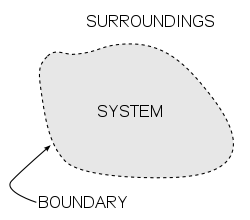Thermodynamics
Thermodynamics is a branch of physics that studies the relations between heat, temperature, and energy. A branch of math called statistics is often used in thermodynamics to look at the motion of particles.
Thermodynamics is useful because it helps us understand how the world of the very small atoms connects to the large scale world we see everyday.
Thermodynamics also has two main branches called classical thermodynamics[1][2] and statistical thermodynamics.[3][4][5] An important idea in thermodynamics is that of a thermodynamic system.
An example of a thermodynamic system is a brick. A brick is made up of many atoms which all have their own properties. All thermodynamic systems have two kinds of properties, extensive and intensive. For the brick, the extensive properties are the ones you get by adding up all the atoms. Things like the volume, energy, mass, and charge are extensive because two of the same brick put together have twice as much mass as one brick. The intensive properties of the brick are the ones you get by looking at the average over all atoms. Things like temperature, pressure, and density are intensive because two of the same brick still has the same temperature as one brick alone.
Laws of thermodynamics
There are four laws of thermodynamics that say how energy can be moved between two objects in the form of heat. The laws of Thermodynamics point out how the energy in a system changes and if the system can work well with its surroundings.
- If two systems have equal heat flow back and forth and one of the two systems has equal heat flow back and forth with another system, all three systems have equal heat flow with each other.
- Given a pair of systems touching with different temperatures, heat will flow from hot to cold until the temperature of the systems becomes equal.
- When a system has a temperature of 0 kelvin, absolute zero (the lowest temperature), the entropy (energy that cannot be used to do work) is at 0.
Uses of thermodynamics
Earlier, thermodynamics was studied to make steam engines work better. Now, ideas from thermodynamics are used in everything from making engines to studying black holes.[6][7]
Scientists use thermodynamics for many reasons. One is to make better engines and refrigerators. Another is to understand the properties of everyday materials so that they can make them stronger in the future. Thermodynamics is also used in chemistry to explain which reactions will work and which will not (this study is known as chemical kinetics[8][9][10][11]). Thermodynamics is powerful because simple models for atoms work well in explaining the properties of large systems like bricks.
Thermodynamics Media
Opening a bottle of sparkling wine (high-speed photography). The sudden drop of pressure causes a huge drop of temperature. The moisture in the air freezes, creating a smoke of tiny ice crystals.
References
- ↑ Pippard, A. B. (1964). Elements of classical thermodynamics: for advanced students of physics. Cambridge University Press.
- ↑ Emanuel, G. (1988). Advanced classical thermodynamics. AIAA.
- ↑ Hill, T. L. (1986). An introduction to statistical thermodynamics. Courier Corporation.
- ↑ Fowler, R. H. (1939). Statistical thermodynamics. CUP Archive.
- ↑ Schrödinger, E. (1989). Statistical thermodynamics. Courier Corporation.
- ↑ Wald, R. M. (2001). The thermodynamics of black holes. Living reviews in relativity, 4(1), 6.
- ↑ Davies, P. C. (1978). Thermodynamics of black holes. Reports on Progress in Physics, 41(8), 1313.
- ↑ Steinfeld, J. I., Francisco, J. S., & Hase, W. L. (1989). Chemical kinetics and dynamics (Vol. 3). Englewood Cliffs (New Jersey): Prentice Hall.
- ↑ Espenson, J. H. (1995). Chemical kinetics and reaction mechanisms (Vol. 102). New York: McGraw-Hill.
- ↑ Frank-Kamenetskii, D. A. (2015). Diffusion and heat exchange in chemical kinetics. Princeton University Press.
- ↑ Connors, K. A. (1990). Chemical kinetics: the study of reaction rates in solution. Wiley-VCH Verlag GmbH.
Related pages
| Wikimedia Commons has media related to Lua error in Module:Commons_link at line 62: attempt to index field 'wikibase' (a nil value).. |

